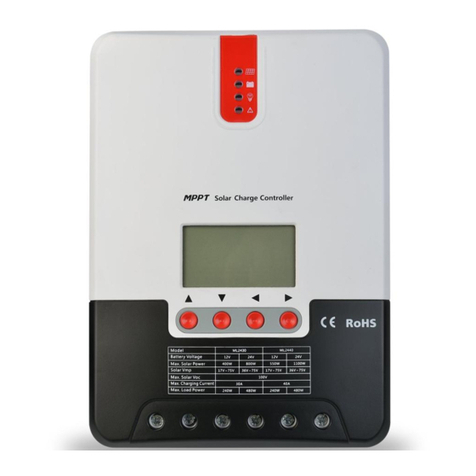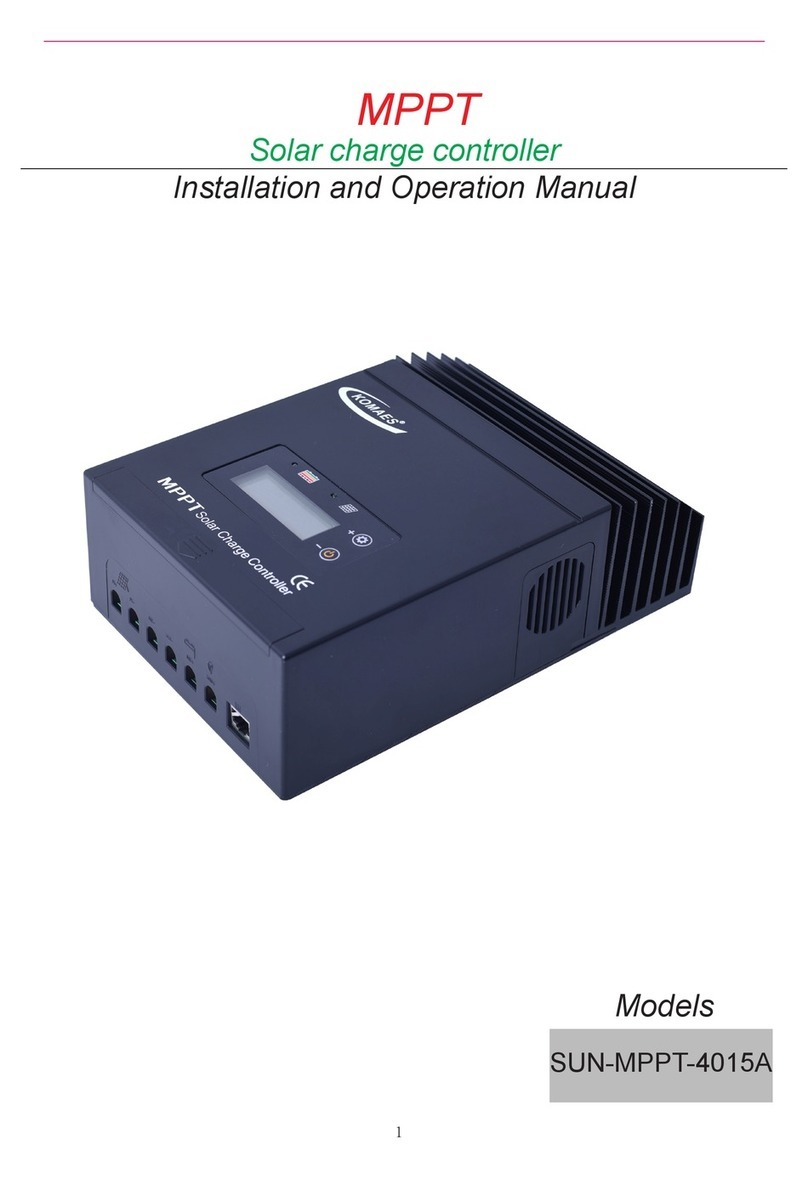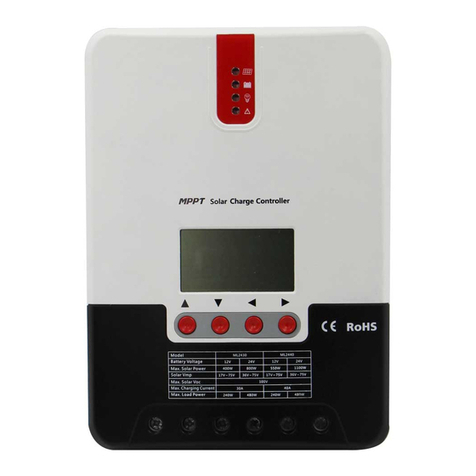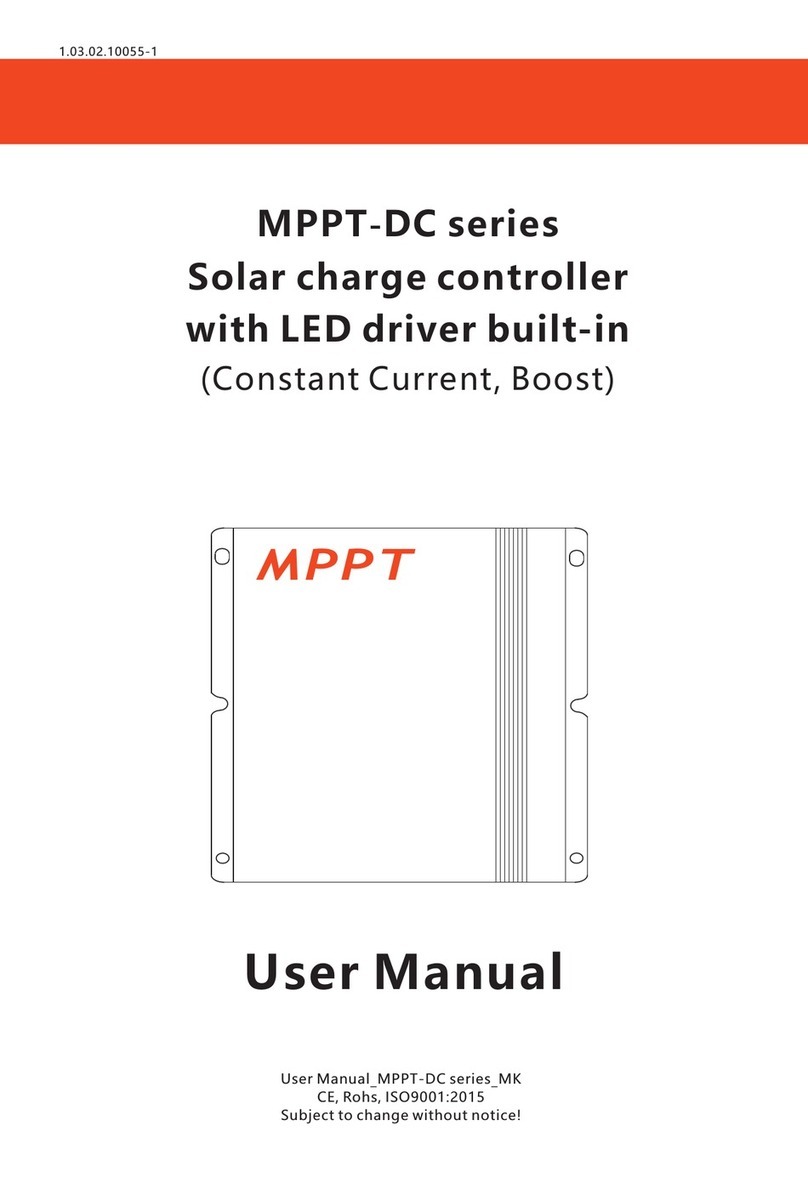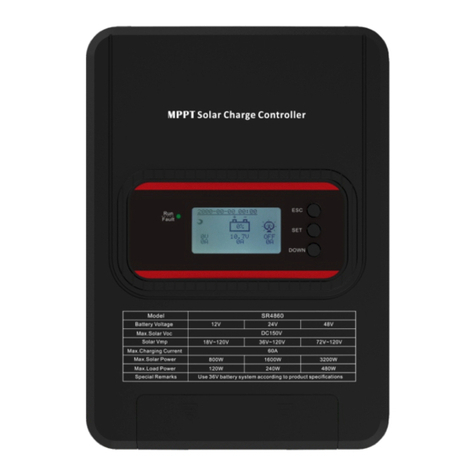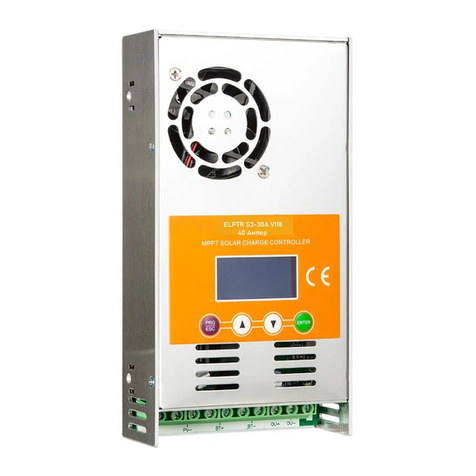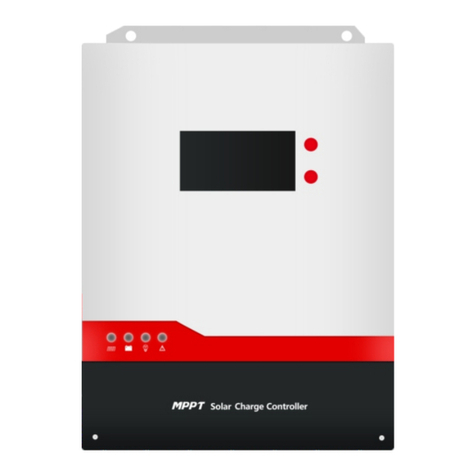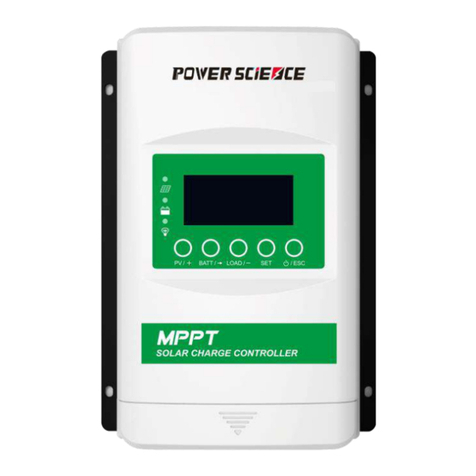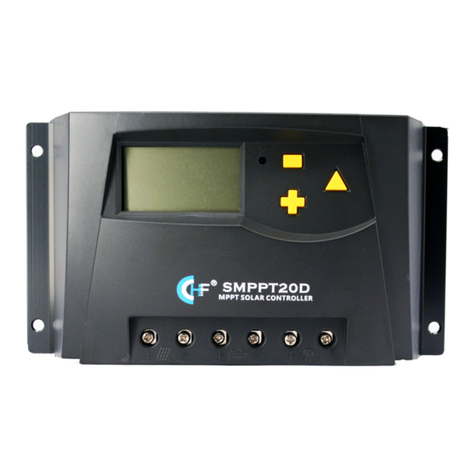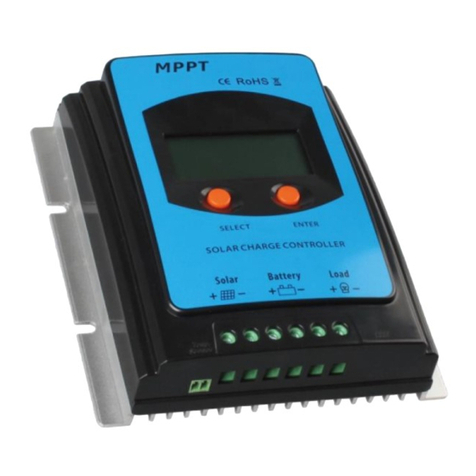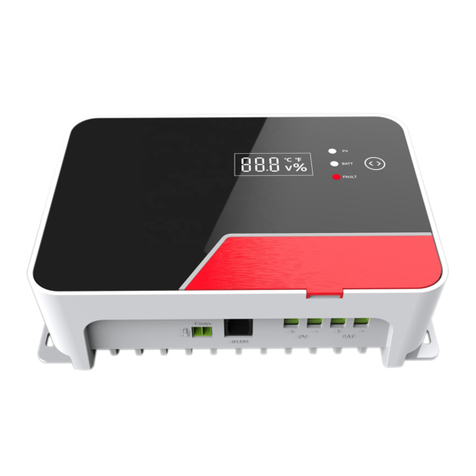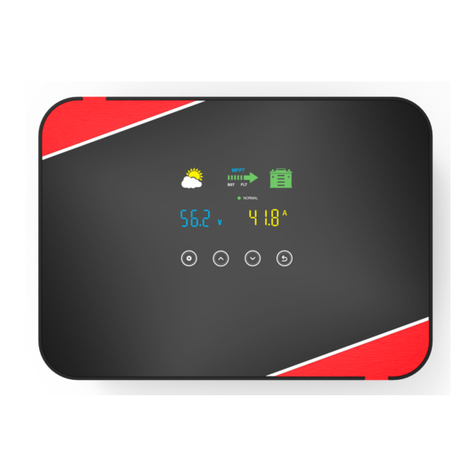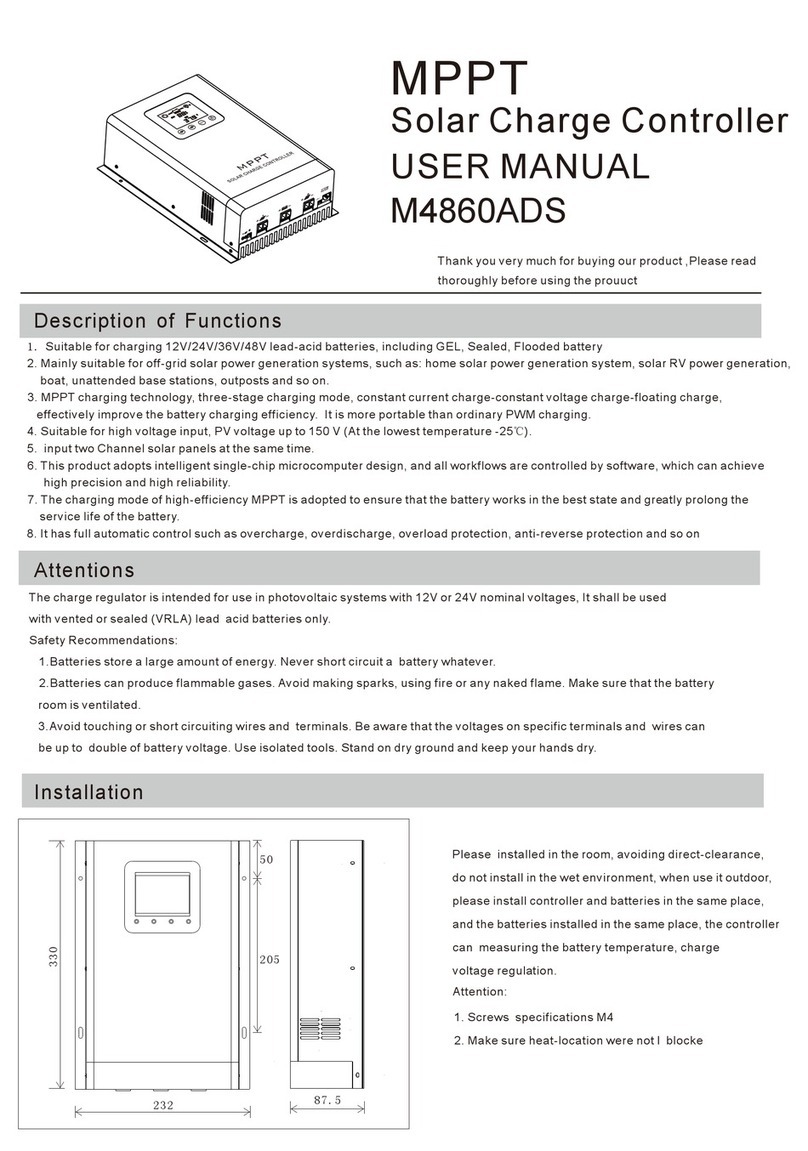
17 18
12. System alarms
System alarms Meaning Description
E0 Normal system No action
E1 Battery over-discharge
Turn off load output, after the battery voltage rises to the over
-discharge reconnect voltage, relieve over-discharge to restore
E2 Battery over-voltage Stop charging, check and find out the cause of high battery
voltage. The charging will be automatically restored after the
E3 Battery under-voltage warning Battery voltage below the under-voltage warning threshold,
E4 Load short-circuited Turn off load output
E5 Load over-current Turn off load output, and perform delay protection by a
E6
Over-temperature protection of
device
When the internal temperature is higher than the set
temperature, start the constant temperature control;
Charging is prohibited when the temperature is higher than
75°C, and charging is resumed when the temperature is lower
E7 Battery over-temperature protection Charging will be stopped when the battery temperature is above
65°C, and automatically resumed when it is below 60°C.
E10 Solar panel over-voltage Charging is stopped, and then automatically resumed when
the solar panel voltage is below the safety limit
E15 Lead acid battery is not connected In lead-acid battery mode, the battery is damaged or not
E16 Battery high temperature discharging
protection
Load output will be turned off when the battery temperature is
above 75°C and resumed when it is below 70°C.
E17 Battery low temperature discharging
protection
Load output will be turned off when the battery temperature is
below -35°C and resumed when it is above -30°C
E18 Overcharge protection Charging is stopped and then resumed 10s after the battery
E19 Battery low temperature charging
protection
Charging will be stopped when the battery temperature is
below -35°C and resumed when it is above -30°C
E30 Charging and discharging disabled
by system setting Off by default (set relevant registers by protocol)
E31 Charging overvoltage, overcurrent
and reverse current protection etc.
After the abnormal conditions are removed, the equipment
will recover automatically Be careful when installing battery. Wear protective goggles when installing a flooded lead-acid
battery. Once in contact with the battery acid, please rinse with water immediately.
Keep away from metal objects to prevent short-circuit of battery.
The battery may produce acid gas when charging. Make sure that the ambient environment is well-
ventilated.
The battery may produce combustible gas. Stay away from sparks.
When installing outdoors, avoid direct sunlight and rain seeping.
The falsely connected connection points and corroded wires may cause great heat, melt the wire
insulation, burn the surrounding materials, and even cause fire. Therefore, it is necessary to ensure
that all connectors are tightened, and the wires are preferably fixed with ties to avoid shaking of the
wires during mobile applications loose connector.
13.Common problems and solutions
Phenomenon Troubleshooting
LCD screen does not light up
There is voltage in the solar panel, there is no
voltage output from the battery side, and code
E1/E15 is displayed
The battery is not detected at the lead-acid battery end,
there is no voltage output from both ends of the battery.
Connect the battery to return to normal or turn on the
lead-acid battery activation switch
12V/24V normal voltage battery is connected,
the battery icon on the LCD screen flashes
slowly, and code E1 is displayed
Check the battery system voltage, or set it to automatically
identify and reboot the controller
The system voltage 12V/24V icon on the
screen flashes
Set system voltage change, prompting the user to reboot
the system for the change to take effect
The controller fails to charge
Check whether there is wrong wiring, whether the solar
panel voltage exceeds the rated value, whether the battery
is over-voltage, whether the LCD screen displays any
error code of internal over-temperature, external over-
temperature,external lithium battery low temperature, or
lead-acid battery open-circuit, and whether it displays
E7/E10, etc.
Charging power does not reach the rated
value
Perform system current limiting and thermostatic control;
Check to see if the system has reset charging current
Other problems or exceptions difficult to
resolve
Try to reboot (F01) or reset controller (F02), and reset
relevant parameters again as per system configurations.
Be careful!
Fail to start some loads Try enabling the load short-circuit function after checking
that the wiring is correct
The screen displays "full", and charging stops
Charging stops as the charging cut-off current conditions
are met. When the voltage is below the boost charging
reconnect voltage, the charging will be automatically
resumed
There is a system alarm code See "12. System alarms" for details
Check whether the battery and solar panel are properly
connected and whether the LCD connection cable has a
poor connection
14.1 Installation precautions
14. Product Installation
multiple of rated current
voltage is lowered
load output
battery voltage is lowered
warning only
than 75°C.
connected.
